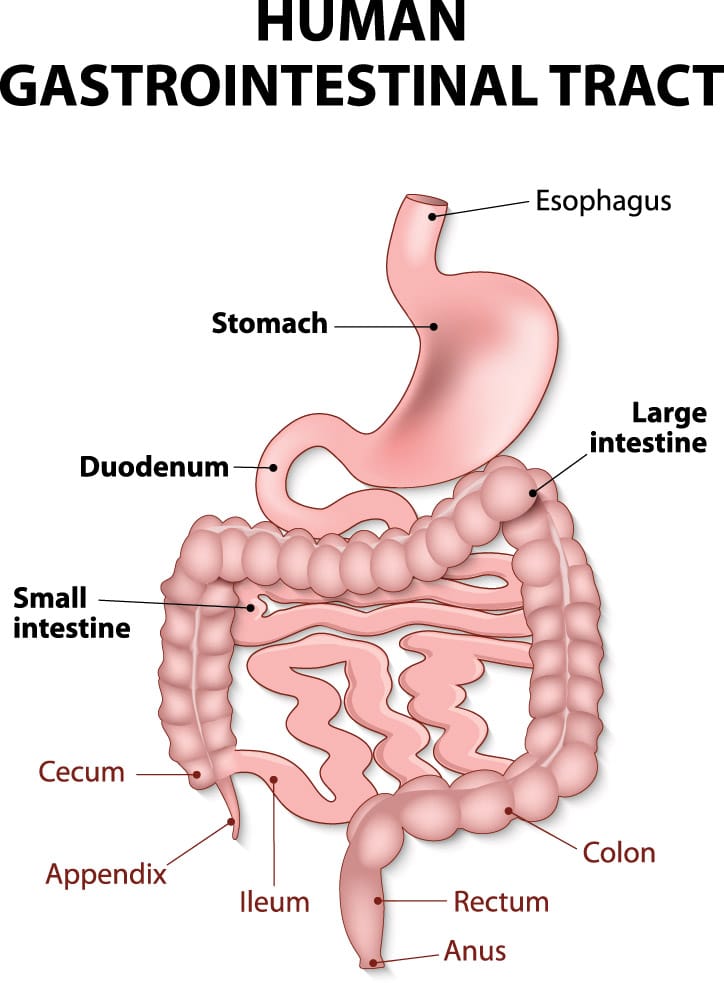Understanding Small Intestinal Bacterial Overgrowth (SIBO)

Small intestinal bacterial overgrowth (or SIBO as many people refer to it) is a condition with a self-explanatory name that is described as an excess of bacteria in the lower intestinal tract. As with many conditions that involve the digestive system, the resulting symptoms — diarrhea, indigestion, stomach cramps and bloating, just to name a few — can lead to major discomfort and pain.
Risk factors for developing SIBO include:
- Normal aging
- Irritable Bowel Syndrome
- Organ system dysfunction, including cirrhosis, renal failure, pancreatitis, and Crohn’s disease (a chronic inflammatory bowel disease that affects the lining of the digestive tract)
- Medications such as recurrent antibiotics and those involved in the suppression of gastric acid
- Motility disorders such as Celiac disease and Gastroparesis (a condition that affects the stomach muscles and prevents proper stomach emptying)
- Metabolic disorders such as Diabetes and Hypochlorhydria (a lack of stomach acid)
- Structural anatomic conditions such as Small Intestine Diverticula (a condition in which small, bulging pouches develop in the digestive tract)
As you can see, small intestinal bacterial overgrowth (SIBO) is often associated with underlying illnesses. And as the disorder worsens, vitamin deficiencies and malnutrition can result from the body’s inability to absorb nutrients from the small intestine. When the normal function of your lower intestine is compromised, bacterial overgrowth may be the cause. And as we all know, normal bacteria in the stomach is vitally important, protecting our intestines from disease and assisting in the digestion of food, vitamins and folic acid.
With SIBO, however, an influx of bacteria can reduce stomach acid or slow down the amount of waste delivered to the colon, effectively backing up the process. And since the colon is less demanding than the small intestine, any backflow of waste reintroduced to the small intestine can be infused with bad bacteria.
Proper diagnosis of SIBO is tricky, but can be narrowed down to four methods:
- Stool tests
- Blood tests
- Breath tests
- Biopsies from the small intestine
Today, few doctor’s offices rely on endoscopy or catheters passed through the intestines to acquire samples — and that’s a good thing. In addition to providing less accurate samplings, these invasive tests are cumbersome and increase the risk of contamination.
Here at Restoration Healthcare, we employ several non-invasive tests to detect and diagnose small intestinal bacterial overgrowth. To start with, all new patients to our practice complete research-based questionnaires as part of their intake. This is to say, we document, very carefully, each patient’s medical history, from which we’re able to generate data that helps us make very informed initial assumption and diagnosis. Depending on our initial analysis and/or the severity of your pain, we may take blood and urine samples to check for the absorption of essential nutrients — keeping in mind that with SIBO, some vitamins will demonstrate a decrease in absorption.
We use those blood and urine samples to look for “markers” of malabsorption and microbial imbalance, as well as toxin and detoxification markers, and detection of essential metabolic fatty acid. In addition, our autoimmune blood tests can identify substances the body is rejecting, thus causing an enhanced state of sensory sensitivity.
Breath tests, which can be conducted here in our office or at home, may help us determine which type of gases the various bacteria are emitting, if any. That in turn provides important data that informs our treatment. (As an aside, we have found breath testing to be the predominant means of evaluating our patients. Its lack of invasiveness, simplicity, and the safety of the procedure all combine to make it our diagnostic approach of choice when we suspect the presence of SIBO.)
Once these tests have been completed and analyzed, we often suggest lifestyle changes, including methods of decreasing stress, obtaining proper sleep and changes in diet (which vary depending on the severity of the case). But that’s not all.
We may also recommend a series neurological exercises — such as gargling, singing, and even self-gagging with a tongue depressor — to stimulate the vagus nerve and strengthen the gut-brain connection. This type of parasympathetic stimulation as it’s called, reprograms the neurologic tone that’s delivered to the small intestine via the vagus nerve, and is strong factor in preventing bacteria from backing up from the large intestine. (Note: If you’re unfamiliar with the role of the vagus nerve, please read Vagus Nerve Stimulation May Improve Well Being here on the Restoration Healthcare Blog.)
Pharmaceutical-grade supplementations and organic herbs are another form of treatment we may recommend. These are likely be added to the equation in order to bring your bacteria under control, as well as establish new beneficial bacteria. Other medications, in the form of antibiotics, can assist in getting a tough SIBO case under control before we introduce healthy bacteria into the system. As is standard, the type and length of treatment depends upon you — our patient — and the symptoms you exhibited and the progress you’re able to make under our care.
Additionally — and this is really important — any underlying disease or illness will also need to be examined once treatment has begun for SIBO. Remember, as we mentioned at the outset of this write up, small intestinal bacterial overgrowth is often associated with other underlying illnesses, and to ignore those would be a mistake.
Call us if you have any questions about this overview of small intestinal bacterial overgrowth or if you feel like it’s time to get tested for SIBO yourself. Our number is (949) 525-2322.

